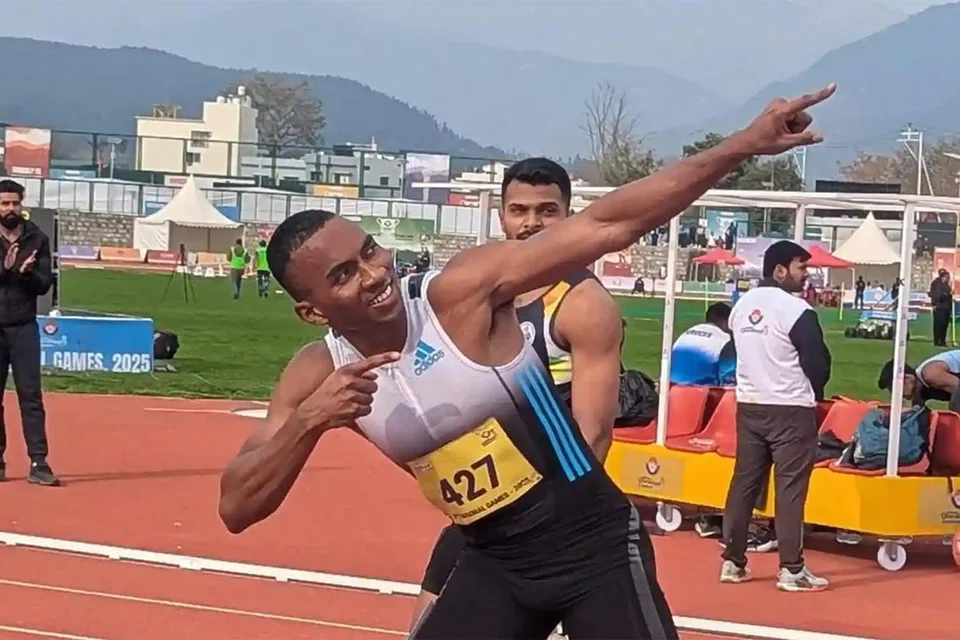At just 22, Animesh Kujur from Chhattisgarh, India, has sprinted into history.
With a blistering run of 20.63 seconds in the men’s 200m at the National Inter-State Athletics Championships in Chennai, he not only claimed gold but also became the first Indian male sprinter to qualify for the World Athletics Championships, to be held in Tokyo next month.
India has long celebrated its middle- and long-distance runners, but sprinting has often remained the country’s weak link. Animesh’s qualification for the biennial global meet marks a watershed moment, reported Sportstar online.
Until now, India’s representation at world-level sprinting has been sparse, with the nation’s hopes mostly pinned on walkers and jumpers.
Animesh has rewritten that narrative. His season has been extraordinary: shattering the 100m national record with a 10.18s run in Greece, twice lowering the 200m mark – the latest being 20.32s at the Asian Athletics Championships in South Korea – and helping India’s 4x100m relay team set a new record of 38.69s.
He also picked up a bronze medal in the 200m at the Asian Championships, becoming only the second Indian to do so in a decade.
Athletics Federation of India (AFI) officials hailed his Tokyo berth as a “turning point” for Indian sprinting. “This is proof that India’s sprinting programme has matured. Animesh is the flag-bearer of a new era,” said an AFI official.
Animesh’s journey began far from the spotlight. Raised in Ghuitangar village near Raipur, Chhattisgarh, he first discovered his speed by chance during a school race, reported Firstpost. Running barefoot, he left classmates trailing and caught the eye of local coaches.
His parents, both athletes themselves, encouraged him to pursue sport seriously. But opportunities were scarce in Chhattisgarh, forcing him to train on makeshift tracks until his talent earned him attention beyond the state.
The turning point came when British coach Martin Owens took him under his wing. Owens worked on Animesh’s raw speed, improving his technique, strength, and confidence.
“We didn’t expect him to break records so early,” Owens admitted. “But Animesh has the rare ability to adapt quickly. For Tokyo, there’s no pressure to win medals – the experience itself is invaluable. When he returns next time, expectations will be higher.”
This year has been nothing short of spectacular for Animesh:
At the Dromia International Sprint and Relays in Greece, he clocked 10.18s in the 100m, breaking Gurindervir Singh’s national record of 10.20s.
In the Asian Athletics Championships at Gumi, Korea, he ran 20.32s in the 200m, eclipsing his own mark and clinching bronze.
In June, at the AtleticaGeneve meet in Switzerland, he ran 20.27s – the fastest 200m time by an Indian, though wind-assisted and hence unofficial.
He later helped India’s relay team smash the 4x100m national record in Chandigarh.
At the Inter-State meet in Chennai, Animesh sealed his World Championships qualification, crossing the line in 20.63s to thunderous applause.
Historically, Indian sprinting has struggled for global recognition. Dharambir Singh came close in 2015 with his bronze at the Asian level, while Amlan Borgohain and others have flirted with continental success. But a berth at the World Championships remained elusive.
Animesh’s rise underscores how better infrastructure, scientific training, and international exposure are changing the game, noted India Today. His participation at the Monaco Diamond League earlier this year gave him a taste of competing against the best, sharpening his composure.
Sprinting experts say his progress could pave the way for India to eventually break the 10-second barrier in the 100m. “It will happen soon – maybe Animesh, maybe someone else. But it will happen,” Owens said.
For all the numbers, what resonates most about Animesh is his story of resilience. Growing up in Bastar’s conflict zones, he often trained without proper shoes or facilities. During the Covid-19 lockdown, he built his own training routine, running on village roads when stadiums were shut.
That grit has defined his career. “These folk songs give importance to everything around us,” Animesh once told a local paper, reflecting on how his upbringing shaped his philosophy. “I run not just for medals but to show what small places can achieve if given the chance.”
Ranked 42nd in the Road to Tokyo standings, Animesh will face seasoned sprinters who regularly dip under 20 seconds. Owens insists Tokyo will be a learning platform, not a medal hunt. “This is about soaking in the atmosphere, understanding the pressure, and returning stronger,” he said.
Animesh agrees. “I’ll be ready for anything. For now, it’s about experience and representing India with pride,” he remarked after his Chennai triumph.
Beyond athletics, Animesh’s rise has stirred optimism across India’s sporting fraternity. His success is viewed as a rallying cry for investment in grassroots infrastructure, especially in under-resourced states like Chhattisgarh.
As The Logical Indian editorially noted: “Kujur’s success is a call to action. It proves that talent exists everywhere – it only needs nurturing.”
As September approaches, Indian athletics braces for its most anticipated sprinting moment yet. Even if medals are out of reach this year, Animesh’s qualification has already broken barriers.
His journey – from dusty school races to the global stage in Tokyo – is proof that India’s sprinting story has only just begun.

